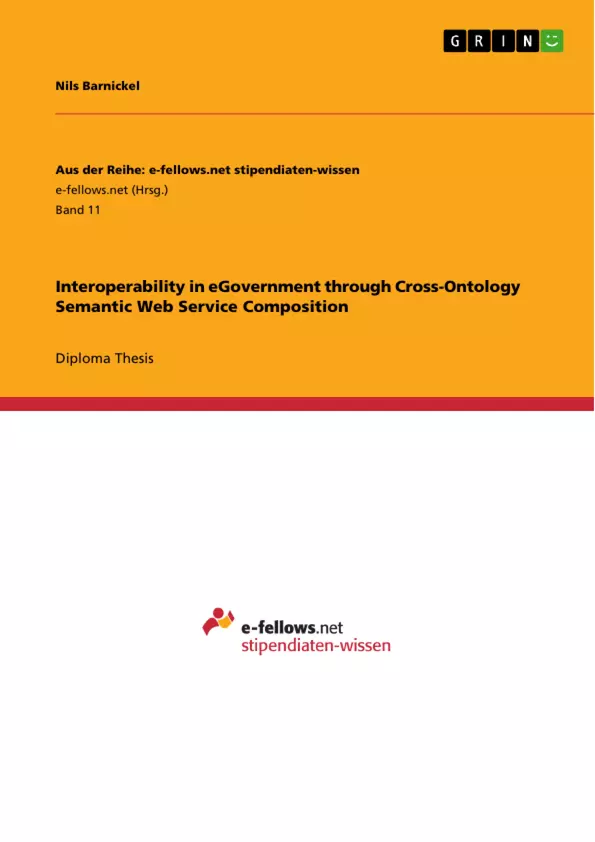Due to the heterogeneous structure of the public sector, the achievement of interoperability is a key challenge for comprehensive electronic government. Service-oriented architectures lay the foundation for flexible application integration and process-orientation through Web service composition. Semantically enriched Web services promise to increase the level of automation and to reduce integration efforts significantly. Furthermore, a relatively high degree of formality in key areas of government activities encourages the application of Semantic Web concepts.
This diploma thesis presents an approach for semi-automatically supporting the design and execution of data flows within the composition of semantically described Web services that are making use of different ontologies and data representations. The approach includes a rule-based mechanism for user-transparent mediation between ontologies. In order to validate the approach, a prototypical cross-ontology Semantic Web service composition tool has been implemented to be used in eGovernment scenarios spanning multiple application domains.
The essence of this thesis was presented at the European Semantic Web Conference 2006 at the Workshop on eGovernment and Semantic Web and is published in the paper.
Inhaltsverzeichnis (Table of Contents)
- Introduction
- Motivation
- Goals and Scope
- Overview
- eGovernment
- Fields of eGovernment
- Administration
- Process Integration
- Semantic Web meets eGovernment
- eGovernment Scenario
- From eGovernment to eGovernance
- State-of-the-art
- Overview
- Interoperability
- Web Services
- Web Service Composition
- Semantic Web Services
- Semantic Information Integration
- Related Work
- Concept
- Overview
- Requirements
- General Idea
- Overall View
- Domain Ontologies and Semantic Web Services
- Semantic Bridges
- Matching and Data Flow
- Process Execution
- Logical Architecture
- Realization
- Overview
- System Architecture for Composition Design
- Semantic Web Services
- Semantic Bridges
- Semantic Web Service Composer
- System Architecture for Composition Execution
- Execution Engine
- Scenario
- Validation and Verification
- Usage
- Evaluation
- Coverage of Goals
- Network Effect
- Conclusion and Outlook
- Summary
- Open Problems
- Future Work
Zielsetzung und Themenschwerpunkte (Objectives and Key Themes)
This diploma thesis aims to develop a semi-automatic approach for supporting the design and execution of data flows within the composition of semantically described Web services. The approach focuses on overcoming the challenge of interoperability in eGovernment by utilizing cross-ontology semantic Web service composition, which involves the mediation of different ontologies and data representations. The approach is validated through the implementation of a prototypical cross-ontology Semantic Web service composition tool, which is then applied to eGovernment scenarios spanning multiple application domains.
- Interoperability in eGovernment
- Semantic Web service composition
- Cross-ontology mediation
- Data flow design and execution
- Prototypical tool implementation and application
Zusammenfassung der Kapitel (Chapter Summaries)
The thesis begins with an introduction that establishes the motivation for the research and outlines the goals and scope of the work. This is followed by a chapter dedicated to eGovernment, exploring its various fields, the role of administration and process integration, and the intersection of Semantic Web technologies with eGovernment. The chapter then presents an eGovernment scenario and discusses the transition from eGovernment to eGovernance.
Chapter 3 delves into the state-of-the-art in interoperability, Web services, Web service composition, semantic Web services, and semantic information integration. It also reviews related work in the field.
Chapter 4 introduces the core concept of the thesis, including the requirements, the general idea, an overall view of the approach, the role of domain ontologies and semantic Web services, the concept of semantic bridges, matching and data flow mechanisms, process execution, and the logical architecture.
Chapter 5 discusses the realization of the concept, including the system architecture for composition design, semantic Web services, semantic bridges, the semantic Web service composer, the system architecture for composition execution, the execution engine, a scenario, validation and verification, and usage.
The thesis concludes with an evaluation of the approach, examining the coverage of goals and the network effect, followed by a summary of the key findings, a discussion of open problems, and an outlook on future work.
Schlüsselwörter (Keywords)
The main focus of this thesis lies in the areas of eGovernment, interoperability, semantic Web services, cross-ontology composition, and data flow management. The key concepts include semantic bridges, rule-based mediation, and the development and application of a prototypical tool for supporting cross-ontology semantic Web service composition. The thesis addresses a critical issue in the field of eGovernment, namely the need for a more efficient and flexible approach to integrating and managing data flows between different public sector organizations.
- Arbeit zitieren
- Nils Barnickel (Autor:in), 2006, Interoperability in eGovernment through Cross-Ontology Semantic Web Service Composition, München, GRIN Verlag, https://www.grin.com/document/173965



